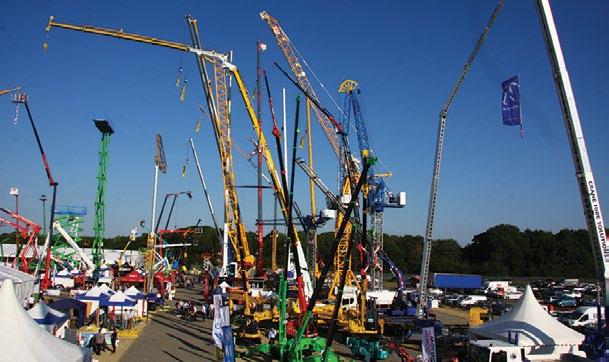
4 minute read
International influences
International influences
Trade shows like Vertikal Days provide an opportunity to see new ways of doing things, often using equipment from other parts of the world, where methods may be entirely different.
National lifting traditions can be pretty arbitrary at times. Sometimes, there’s a clear rationale: it makes sense to use a tight out of service hydraulic luffing tower crane in London, where oversailing costs, while a big conventional luffer is best suited in New York, where speed, fast pours, and large concrete modules are the name of the game.
But other traditions are harder to understand. Why do Indian buyers stick with local tractor cranes, when a Chinese built truck crane or Australian pick & carry machine, would do the job more safely?
Why do many rental companies offer an All Terrain, quoting the nominal capacity as if it is all that matters, when a mobile self-erecting tower crane, aluminium truck crane, or big loader crane, might be a better tool for the job?

A Chinese telecrawler
For almost 20 years, Chinese crane manufacturers have been trying to build a presence in international markets. In some places, and market segments, they have had huge success, Chinese truck cranes are used throughout the developing world, while excavators and more recently aerial work platforms are doing well in western markets. The mobile crane market, however, has proved more of a challenge, due to concerns over issues such as long term support and resale values. A new relationship between Sany, its joint venture partner Palfinger and UCM/Verschuur in the Netherlands hopes to change that, bringing a range of Sany telescopic and lattice boom crawlers to Europe, backed by local support and close links with the plant in China.
In the UK they have teamed up with Foster Cranes, which took a stand to showcase a 60 tonne Sany SCE600TB telecrawler, this one having been sold to Dutch rental company Van Der Vlist. The crane has a 46 metre boom, which is six metres more than Liebherr’s LTR 1060. UCM Verschuur’s Jan Janssen also claims that the load chart is stronger at short radii than its three leading European rivals.
The undercarriage retracts from 4.8 to three metres for transport, and while it weighs almost 65 tonnes, the 19 tonne counterweight is quickly and easily removed. When the show ended the crane was loaded up and heading for the port within an hour or two of the show closing. The next crane up in the range, the SCE800TB, is almost as quick and easy to move.
Janssen hopes strong regional parts and service effort will make a difference, UCM’s engineers say that the Sany cranes are easy to work with, while they also have the support of eight Sany employees from China based at UCM’s base near Amsterdam, where the company also has a fully stocked parts warehouse.

Aluminium booms extend further
In recent years Vertikal Days has been a key shop window for the German built aluminium cranes. Initially from Böcker, through Kranlyft. Böcker now runs a direct sales operation in the UK, while Kranlyft now represents Klaas.
These cranes won’t win any nominal rating contests. But they do score when it comes to lifting smaller loads at height and long radii. Böcker had its six tonne AK46 and 12 tonne AK52 at the show, on different chassis, alongside trailer cranes and hoists. Jake McCaugherty of Böcker UK says his rental customers are now being asked for these cranes on housebuilding projects, where once a 40 tonne All Terrain would have been used.

Simon Marnock, of Kranlyft echoes that view, stating that the light weight manoeuvrable long reach cranes are proving ideal for handling roof trusses, small cooling units, and a wide range of similar work. “The advantages of these cranes really stand out on the road,” says Marnock. “They’re so cheap to run, compared to 50 or 60 tonne All Terrains.”

A carry deck for any terrain
Another exhibit that caught my eye was a six tonne dual axis self-levelling tracked carrier on the AlmaCrawler stand, equipped with a 990kg capacity loader crane. The carrier can pick its way around steep slopes like a mountain goat, while keeping the carry deck completely level at all times.
The tracked carrier/micro crane combination is already well proven, Alma’s Jonathan Vioni tells me. It’s been used by ski slope operators to move cooling components around, sometimes making maximum use of the carry deck capacity. The crane can be easily removed in such cases and reattached later.















